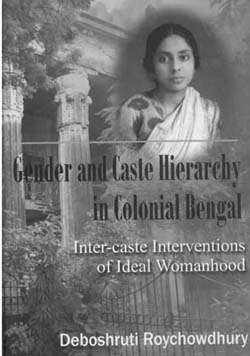Gender and Caste Hierarchy in Colonial Bengal by Deboshruti Roychowdhury explores how different ranks of caste groups in colonial Bengal contemplated the ‘ideal woman’. The subtitle suggests that the book might talk about significant ‘interventions’ by subordinate castes on the ‘women’s question’ in colonial Bengal, interventions that could possibly bring out the contested and variegated nature of the ideal(s). Reading the book, however, makes it clear that the author’s point is about ‘Brahmanical hegemony’ being ‘something truly total in nature’ (p. 217). Thus the author argues that claims of superior status in terms of caste were organically linked to claims of ‘purity’ which, in turn, placed oppressive burdens of chastity, fidelity, subservience and self-sacrifice invariably on women. Amid unprecedented opportunities offered by the colonial regime, low caste groups saw their improvement of social status in the imposition of oppressive patriarchal norms, ‘Brahmanical in nature’ (p. 216), on their women. Roychowdhury assumes that this meant a loss to lower caste women’s erstwhile relative freedom ‘whose way of life was subjected to fiercer scrutiny than ever before’ (p. 204). To quote her: ‘The absence of free choices for women thus became a ubiquitous phenomenon prevalent across almost all the social strata of colonial Bengal’ (p. 9).
Which castes of Bengal does Roychowdhury refer to in her book as ‘low-caste groups’ and assume to have been relatively less restrictive—in terms of Brahmanical gender codes—on women in pre-colonial times? Apart from a sparse mention of Dalit groups like Namasudras and Rajbangshis drawn entirely from secondary literature, Roychowdhury’s book does not deal with degraded castes of Bengal like the Bagdi, Muchi, the several fishermen castes or even the internally stratified Pod. The blurb itself tells that Roychowdhury’s subjects are the relatively middle-positioned castes (whom she calls ‘marginalised so-called lower castes’) like ‘Subarnabaniks (gold merchants), Gandhabaniks (spice merchants), Mahishyas (prosperous farmers), Sadgopes (prosperous peasantry)’. Elsewhere she also includes the Tili and Teli (oil-pressers). By looking at caste journals of the early twentieth century, the author concludes that ‘low-caste women’ now ‘had for the first time the burden of protecting the honour of their entire community’ (p. 204, emphasis mine). The blanket category ‘low’, in this work, collapses the considerable distinctions of ritual status between ‘clean’ Sudra castes and degraded/ ‘antyaja’ castes. For ‘clean’ castes like Sadgopes, Brahmanical restrictions on women were hardly new.

